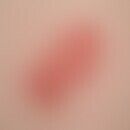Synonym(s)
DefinitionThis section has been translated automatically.
Chronic hand eczema is defined as "hand eczema" which does not heal over a period of 3 months despite adequate dermatological therapy and the patient's cooperation or which recurs at least twice within a period of 12 months. The severity of chronic hand dermatitis can be very variable:
- Mild hand dermatitis heals quickly with adequate dermatological therapy and the patient's cooperation.
- Moderately severe hand dermatitis persists for several weeks despite adequate dermatological therapy and patient involvement.
- Severe hand dermatitis is an extensive permanent or recurrent skin change of considerable disease value with e.g. rhagades, pronounced lichenification and infiltration.
Chronic hand dermatitis is of great relevance for social medicine and health economics. They are associated with high costs and a considerable loss of quality of life. In particular, chronic severe hand eczema causes long periods of illness with incapacity to work and is often refractory to therapy.
ClassificationThis section has been translated automatically.
Chronic hand dermatitis can be classified according to aetiology (atopic, allergic, irritant [cumulative subtoxic]), clinical morphology (redness, scaling, lichenification, vesicles, hyperkeratosis, rhagades, etc.) and localisation of the skin changes (back of the hand, interdigital spaces, palms) (see also hand dermatitis).
In diagnostic classification, overlapping disease entities as well as multifactorial etiology and mixed forms are common.
You might also be interested in
Occurrence/EpidemiologyThis section has been translated automatically.
The 1-year prevalence of hand dermatitis is estimated to be up to 10% in adults (20-65 years) and the incidence is about 5 per 1000 adults. 52% of hand dermatitis is classified as occupational. Chronic hand dermatitis is responsible for about 7% of all hand dermatitis.
EtiopathogenesisThis section has been translated automatically.
S.u. hand dermatitis.
LocalizationThis section has been translated automatically.
Clinical featuresThis section has been translated automatically.
Differential diagnosisThis section has been translated automatically.
Psoriasis pustulosa palmaris et plantaris: usually sharply defined erythema, rough papules and plaques, sometimes with single or multiple, smaller vesicles and pustules as well as scaling and rhagades. Typically no spreading to the forearms on the flexion side, no scattering phenomena; frequently also infestation of other predilection sites.
Psoriasis palmaris (dry hyperkeratotic form): sharply defined (!), red or white-grey, scaly, sometimes wart-like, rough, firm plaques on the palms of the hands. Typically no spreading to flexed forearms; no scattering phenomena. Often also infestation of other predilection sites!Cave! You have to search for it!
Tinea manuum: mostly finely lamellar scaly, itchy, low consistency increased plaques; dyshidrotic vesicles or extensive hyperkeratosis are also possible; a positive mycological proof is diagnostic.
Skabies: especially the interdigital folds of the hands are affected with very itchy vesicles and papules; palms are usually only affected in infants, toddlers and elderly people.
Palmo-plantar syphilide: maculopapular skin changes, occurring in the context of an exanthematic syphilide; always skin changes also in other skin areas.
Artefacts: red spots, papules and plaques up to sharply defined, mainly circular, crusty ulcers in artificial shape and arrangement; typically in an easily accessible localization.
Bowen's disease: solitary, sharply defined, superficially scaling, partly crusty, yellow-brown plaque with focal nodules.
Mycosis fungoides: sharply defined, large, red, smooth, atrophic plaques with a tendency to ulceration.
Keratosis palmoplantaris: hereditary or symptomatic cornification disorder in the form of areas with a waxy thickened and yellowish discoloured horny layer of the palms of the hands and soles of the feet.
Lichen planus (palmar): suddenly appearing, very itchy, reddened, polygonal, sometimes confluent, rough and smooth papules and plaques as well as partially flat, yellowish hyperkeratoses; usually occurring in the context of an exanthematic lichen planus; diagnosis on the basis of extrapalmar skin changes.
TherapyThis section has been translated automatically.
External therapyThis section has been translated automatically.
Therapy is based on the pathogenesis and severity of chronic hand eczema. A complete functional regeneration of the epidermal barrier occurs only in the course of several weeks or months after healing of a chronic hand eczema. It is therefore important to ensure that affected persons observe a sufficiently long period of rest from skin-irritating exposure.
In the treatment of chronic hand eczema, the general therapeutic principles of stage-appropriate eczema therapy must be observed. A prerequisite for successful therapy is the recognition and avoidance of causative exogenous factors (e.g. allergens, irritants).
The therapy of chronic hand eczema follows a step-by-step concept:
- Basic therapy: Consistent re-fattening of the skin with products that are as free of preservatives and fragrances as possible. In the acute stage, treatment is with compresses, lotions or creams, in the sub-acute stage with ointments and in the chronic stage with fatty ointments.
- Keratolytic agents: salicylic acid (up to 20%, corneal layer dissolving effect especially in hyperkeratotic-rhagadiform hand eczema) and urea (5-10%; corneal layer softening, smoothing, penetration promoting and water-binding effect), especially in hyperkeratotic-rhagadiform hand eczema.Caution! Excessive or incorrect dosage, occlusion or simultaneous irritant exposures may cause skin irritation, redness and burning. Attention must be paid to a possible penetration-promoting effect. If necessary, use a well tolerated base with an addition of 2-10% urea (e.g. Basodexan ointment/fat cream, Excipial U Lipolotio, Linola Urea cream, Nubral cream).
- Glucocorticosteroids: The targeted and correct use of glucocorticosteroids is still of central importance for the anti-inflammatory topical local therapy. The potency of the corticosteroid used and the duration of therapy depend on the severity of the chronic hand eczema and the localisation. Always in combination with replenishing steroid-free local therapy. Use systemic corticosteroids only in special cases. Do not use topical corticosteroids for a long period of time. It is better to use sufficiently strong corticosteroids for a short period of time in acute attacks and then to eliminate them as quickly as possible. If the findings worsen, the possibility of contact sensitization to the corticosteroid itself or to ingredients of the topical agent should be considered and clarified diagnostically by means of epicutaneous testing.Caution! In chronic hand eczema, dermal skin atrophy and epidermal barrier damage are particularly significant as undesirable side effects. This can complicate the functional restoration of the epidermal barrier and thus a long-term medical rehabilitation. Glucocorticoids of category 2 with the highest possible therapeutic index (TIX > 2) are particularly recommended in the therapy of chronic hand eczema as they show a particularly favourable ratio of desired to undesired effects. Pronounced acute inflammatory hand eczema episodes may justify the short-term use of higher potent corticosteroids with a lower TIX. Furthermore, in chronic hyperkeratotic rhagadiform hand eczema, treatment with a highly potent glucocorticoid such as clobetasol propionate may be indicated and may be superior to treatment with glucocorticoids of lower potency and higher TIX in order to exploit the antiproliferative effect in these forms of eczema, since per se a lower drug penetration can be assumed.
- Topical calcineurin inhibitors: especially for the treatment of atopic hand eczema. The occurrence of skin atrophy with further reduction of the barrier function can be prevented.
- Other topical therapeutic agents: In superinfected eczema, antimicrobial substances may be used (e.g. clioquinol (vioform), chlorhexidine). The addition of preparations containing tar (e.g. liquor carbonis detergens, ichthyol or tumenol) has anti-inflammatory, anti-pruritic and anti-proliferative effects. Clinical experience has been gained in the treatment of hyperkeratotic-rhagadiform and vesicular hand eczema with cignoline (dithranol) (DD psoriasis).
- Tap water iontophoresis: Use in case of additional hyperhidrosis and dyshidrotic hand eczema.
Radiation therapyThis section has been translated automatically.
Internal therapyThis section has been translated automatically.
Chronic severe hand eczema that does not respond adequately to local therapeutic measures may require early initiation of systemic therapy. Alitretinoin is approved for the treatment of chronic hand eczema and has shown convincing efficacy in clinical studies. Ciclosporin should only be used for severe, therapeutically uncontrollable chronic hand eczema (off-label use).
Alitretinoin: Approved for the treatment of chronic severe hand eczema that does not respond or does not respond adequately to treatment with potent topical corticosteroids. Alitretinoin is an agonist of both vitamin A acid receptors and has a primary immunomodulatory and anti-inflammatory effect (in contrast to retinoids, it hardly dries out at all). In a phase III study, the so-called BACH study (Benefit of Alitretioin in Chronic Hand Eczema), it was shown that the symptom score of chronic hand eczema with alitretinoin 30 mg improved by 75% after 24 weeks of therapy. Every second patient achieved complete or almost complete healing under the 30 mg dosage. 65% remained recurrence-free in the 6-month follow-up phase. Of the patients who had to be retreated, 80% healed completely again under alitretinoin 30 mg, so that alitretinoin can also be used for the long-term management of chronic hand eczema. The recommended standard dosage of alitretinoin is 30 mg/day p.o.; in patients with insufficiently adjusted lipid metabolism disorder, therapy should be started with 10 mg once/day. Therapy should be carried out over 12-24 weeks or until healing. Studies have shown that continuation of the therapy can bring additional improvement. Alitretinoin was generally well tolerated; headaches, which occurred particularly within the first 10 days after the start of therapy and were temporary, are the most frequently observed side effect (in about 20% of patients). Like all vitamin A acid derivatives, alitretinoin is teratogenic. For this reason, women of childbearing age should undergo a pregnancy prevention programme (analogous to isotretinoin), which includes detailed information, safe contraception and regular medically supervised pregnancy tests one month before, during and up to one month after discontinuation.
Glucocorticoids, systemic: Not suitable for the treatment of chronic hand eczema due to the side effect profile and lack of clinical studies on efficacy.
Ciclosporin A: only to be used for severe, therapeutically uncontrollable chronic hand eczema ( off-label use). Therapy for a maximum of 6 months at the lowest therapeutically effective dose with subsequent dose reduction over a period of approx. 3 months. In some patients, however, a 6-month therapy is not sufficient to achieve sustained clinical success. With a good response, the therapy can be terminated earlier. If there is no response within 8 weeks, it is recommended to stop the administration of Ciclospor.
Further therapeutic measures: There are no randomized clinical studies for further therapeutic measures used in individual cases ( off-label use) such as methotrexate, azathioprine, etc. A symptom-related concomitant medication (e.g. antihistamines, antibiotics) can be helpful in individual cases. Psychotherapeutic measures can be useful in particular for chronic severe hand eczema.
LiteratureThis section has been translated automatically.
- Augustin Met al (2016) The influence of alitretinoin on the quality of life in patients with severe chronic hand eczema: FUGETTA observational study
under field conditions. J Dtsch Dermatol Ges 14:1261-1272. - Diepgen TL (2008) Chronic hand eczema - epidemiology and therapeutic evidence. dermatologist 59: 683-689
- Diepgen TL, Elsner P, Schliemann S, Fartasch M, Köllner A, Skudlik C, John SM, Worm M, Deutsche Dermatologische Gesellschaft (2009) Management of hand eczema - Guideline - ICD-10-digit: L20. L23. L24. L25. L30. J Dtsch Dermatol Ges 7 (Suppl. 3): S1-16
- Molin S, Ruzicka T (2008) Alitretinoin - The first specifically approved therapy for chronic hand eczema. dermatologist 59: 703-709
- Raap U, Kenneweg C, Kapp A, Werfel T (2008) New and less frequently used treatment options for therapy-refractory hand eczema - local UVA-1 phototherapy, retinoids, calcineurin inhibitors. dermatologist 59: 710-716
- Ruzicka T (2008) Chronic hand eczema - A solution in sight. dermatologist 59: 682
- Ruzicka T et al (2009) Efficacy and safety of oral alitretinoin (9-cis retinoic acid) in patients with severe chronic hand eczema refractory to topical corticosteroids: results of a randomized, double-blind, placebo-controlled, multicentre trial. Br J Dermatol 158: 808-817
- Stege H (2008) Ultraviolet therapy of chronic hand eczema. dermatologist 59: 696-702
Outgoing links (19)
Alitretinoin; Artifacts; Azathioprine; Bowen's disease; Ciclosporin a; Clobetasol-17-propionate; Glucocorticosteroids systemic; Hand dermatitis (overview); Isotretinoin; Lichen planus classic type; ... Show allDisclaimer
Please ask your physician for a reliable diagnosis. This website is only meant as a reference.












